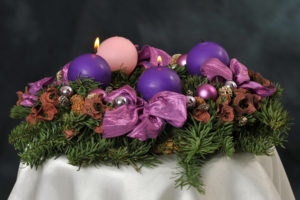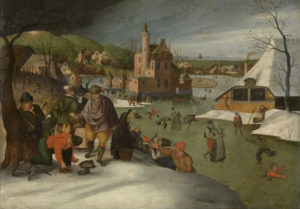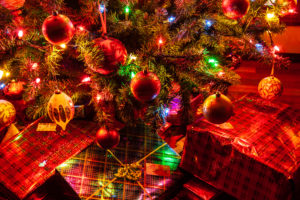Advent – Preparation not Anticipation
by Fr. William Rock, FSSP

As early as the day after Halloween, Christmas music begins to be heard. Perhaps even earlier, stores will decorate for Christmas with the associated holiday wares displayed. Throughout December, TV channels will play collections of Christmas movies. Then, on the 26th of December, it all comes to screeching halt. Trees are out on the curb, decorations come down, and we return to our regularly scheduled programing. This way of keeping Christmas, and the days leading up to it, is not the way our Catholic forefathers would have kept it. Christmas and its days were celebrated as Christmas, while the days leading up to Christmas, the days of Advent, were kept as days of preparation, not anticipation.1
As Lent is a penitential period of preparation for Feast of the Resurrection of Our Lord, so Advent (from the Latin for “a coming, an approach, arrival”)2 was a penitential period of preparation for the Feast of the Nativity of Our Lord and for receiving the special graces which accompany it. Advent, then, was considered a mini-Lent. While Church Law has not bound the Latin faithful to penance during Advent in some time, the season still carries the marks of being penitential. The Gloria is not sung during Masses of the Season, the penitential violet is worn, the Altar is not decorated with flowers, and the organ is silent. Historically, the Ite, Missa est was replaced by the Benedicamus Domino and the Deacon and Subdeacon would lay aside their vestments of joy for the folded chasuble. It is incongruous, then, for the faithful to begin keeping Christmas at home while the Church is in such a period of preparation. How then, can the faithful keep this season of Advent in a fitting way, not corrupting this time of preparation by following the world but rather in a Catholic spirit?

The first way would be to undertake acts of penance. Even if this is not currently enjoined by Church Law, it would be completely in keeping with the liturgical expression of the season. In 1962, the Vigil of Christmas (which is Christmas Eve day, not anticipated Masses said in the evening of the 24th and not the Midnight Mass, which is the First Mass of Christmas) was still kept as a day of fasting and complete abstinence. Additionally, in 1962, Ember Wednesday and Ember Saturday of Advent were days of fasting and partial abstinence (meat only at the main meal) while the Ember Friday was a day of fasting and complete abstinence. It is important to keep in mind that Advent does not only prepare for the liturgical commemoration of the coming of Christ into this world, but also for the coming of Christ into the souls of the believers, and, more, His coming at the end of time as Judge. All three provide ample reason for each to prepare his soul by penitential exercises.
When it comes to decorating, the house should not be adorned for Christmas until slightly before the feast itself. However, Advent Wreaths, Advent Calendars, and Jesse Trees can and should be used as decorations in the weeks leading up to the Nativity. The tree, as it might need to be purchased some time prior to the feast, can be set up and perhaps decorated in a way that befits this season of preparation, perhaps with violet and rose. The lights could be put on, but not yet turned on. With respect to the Nativity creche, the following schedule could be followed, coordinating with the Church’s liturgy:
-
- First Sunday of Advent – Set up the creche (stable-cave) with animals
- Ember Wednesday – Add the figure of Mary as this is the first time she is presented in a Gospel of the Season
- Christmas Eve Day/Vigil of Christmas – Add the figure of Joseph as the Gospel of the Vigil Mass is about his dream-vision
- Following the Christmas Midnight Mass – Add the figures of the Angel and of the Christ Child, as His temporal birth is recounted in the Gospel
- Following the Dawn Mass of Christmas (the Shepherds’ Mass) – Add the figures of the shepherds as the Gospel of the Mass recounts their going to the stable
- Epiphany – Add the figures of the Magi

When it comes to music, Christmas carols are best omitted until the feast itself. Advent songs are, of course, highly recommended. The Fraternity of St. Peter, the Benedictines of Gower, and the Monks of Clear Creek all have Advent albums. Songs concerning winter can also be sung keeping in mind that Winter starts astronomically at the winter solstice and the Advent Ember Days liturgically mark the transition from Autumn to Winter. Note too that historically at the liturgy of the First Sunday of Advent, clerics would transition from the Autumn to the Winter volume of the Breviary. Wintery decorations would not be out of place either.
Several feasts punctuate the Season of Advent, such as the Feasts of St. Barbara (December 4th), St. Nicholas (the 6th), St. Lucy (the 13th). Each have their particular home-traditions which the faithful would do well to observe.
Special attention should be given to the Magnificat antiphons sung at Vespers from 17th to 23rd of December inclusively, the Greater Ferias of Advent. These antiphons are known as the “Great Antiphons” or the “O Antiphons” (as they all start with “O”). Unlike throughout the year, these Magnificat antiphons are sung standing. Each antiphon invokes the Messias under a different title: Sapientia (Wisdom), Adonaï (Lord), Radix Jesse (Root of Jesse), Clavis David (Key of David), Oriens (Orient / Day-spring), Rex Gentium (King of the Nations / King of the Gentiles), and lastly Emmanuel (Emmanuel / God is with us). The first letter of each of these titles can be read as a backwards acrostic which spells, in Latin, “Ero cras,” meaning “Tomorrow I will be [there].” These Antiphons are the basis of the hymn “O Come, O Come Emmanuel.”

Having kept Advent in such manner, the faithful will be much better prepared to celebrate Christmas and receive the special graces of the season than had the practices of the world been followed. When the time comes, Christmas should be kept as Christmas, with the decorations, carols, food, and all of the trimmings! This celebration should be extended at least until the Feast of the Epiphany (the 13th Day of Christmas), or the Commemoration of the Baptism of the Lord (the Octave Day of the Epiphany), or even to the 40th and Last Day of Christmas, Candlemas.
William Rock, FSSP was ordained in the fall of 2019 and is currently assigned to Regina Caeli Parish in Houston, TX.
- Much of the historical and liturgical information contained within this article comes from Guéranger, Prosper. The Liturgical Year, 1 (Advent). Trans. Shepherd, Laurence. (Fitzwilliam: Loreto Publications, 2000), chapters 1-3.
- Lewis and Short, s.v. “Adventus.”
November 21, 2022








